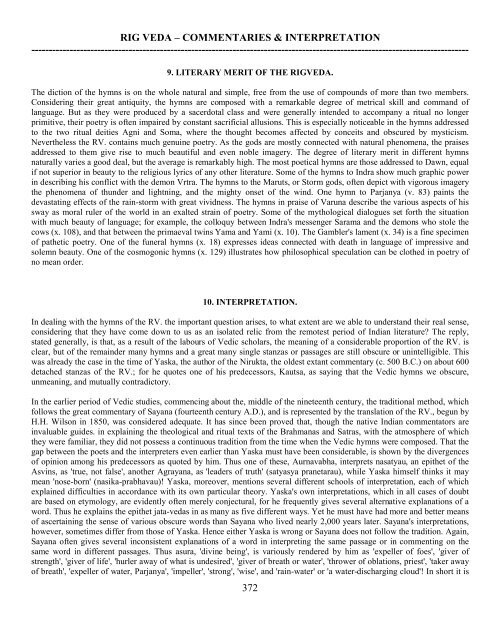You also want an ePaper? Increase the reach of your titles
YUMPU automatically turns print PDFs into web optimized ePapers that Google loves.
RIG VEDA – COMMENTARIES & INTERPRETATION<br />
------------------------------------------------------------------------------------------------------------------------------<br />
9. LITERARY MERIT OF THE RIGVEDA.<br />
The diction of the hymns is on the whole natural and simple, free from the use of compounds of more than two members.<br />
Considering their great antiquity, the hymns are composed with a remarkable degree of metrical skill and command of<br />
language. But as they were produced by a sacerdotal class and were generally intended to accompany a ritual no longer<br />
primitive, their poetry is often impaired by constant sacrificial allusions. This is especially noticeable in the hymns addressed<br />
to the two ritual deities Agni and Soma, where the thought becomes affected by conceits and obscured by mysticism.<br />
Nevertheless the RV. contains much genuine poetry. As the gods are mostly connected with natural phenomena, the praises<br />
addressed to them give rise to much beautiful and even noble imagery. The degree of literary merit in different hymns<br />
naturally varies a good deal, but the average is remarkably high. The most poetical hymns are those addressed to Dawn, equal<br />
if not superior in beauty to the religious lyrics of any other literature. Some of the hymns to Indra show much graphic power<br />
in describing his conflict with the demon Vrtra. The hymns to the Maruts, or Storm gods, often depict with vigorous imagery<br />
the phenomena of thunder and lightning, and the mighty onset of the wind. One hymn to Parjanya (v. 83) paints the<br />
devastating effects of the rain-storm with great vividness. The hymns in praise of Varuna describe the various aspects of his<br />
sway as moral ruler of the world in an exalted strain of poetry. Some of the mythological dialogues set forth the situation<br />
with much beauty of language; for example, the colloquy between Indra's messenger Sarama and the demons who stole the<br />
cows (x. 108), and that between the primaeval twins Yama and Yami (x. 10). The Gambler's lament (x. 34) is a fine specimen<br />
of pathetic poetry. One of the funeral hymns (x. 18) expresses ideas connected with death in language of impressive and<br />
solemn beauty. One of the cosmogonic hymns (x. 129) illustrates how philosophical speculation can be clothed in poetry of<br />
no mean order.<br />
10. INTERPRETATION.<br />
In dealing with the hymns of the RV. the important question arises, to what extent are we able to understand their real sense,<br />
considering that they have come down to us as an isolated relic from the remotest period of Indian literature? The reply,<br />
stated generally, is that, as a result of the labours of Vedic scholars, the meaning of a considerable proportion of the RV. is<br />
clear, but of the remainder many hymns and a great many single stanzas or passages are still obscure or unintelligible. This<br />
was already the case in the time of Yaska, the author of the Nirukta, the oldest extant commentary (c. 500 B.C.) on about 600<br />
detached stanzas of the RV.; for he quotes one of his predecessors, Kautsa, as saying that the Vedic hymns we obscure,<br />
unmeaning, and mutually contradictory.<br />
In the earlier period of Vedic studies, commencing about the, middle of the nineteenth century, the traditional method, which<br />
follows the great commentary of Sayana (fourteenth century A.D.), and is represented by the translation of the RV., begun by<br />
H.H. Wilson in 1850, was considered adequate. It has since been proved that, though the native Indian commentators are<br />
invaluable guides. in explaining the theological and ritual texts of the Brahmanas and Satras, with the atmosphere of which<br />
they were familiar, they did not possess a continuous tradition from the time when the Vedic hymns were composed. That the<br />
gap between the poets and the interpreters even earlier than Yaska must have been considerable, is shown by the divergences<br />
of opinion among his predecessors as quoted by him. Thus one of these, Aurnavabha, interprets nasatyau, an epithet of the<br />
Asvins, as 'true, not false', another Agrayana, as 'leaders of truth' (satyasya pranetarau), while Yaska himself thinks it may<br />
mean 'nose-born' (nasika-prabhavau)! Yaska, moreover, mentions several different schools of interpretation, each of which<br />
explained difficulties in accordance with its own particular theory. Yaska's own interpretations, which in all cases of doubt<br />
are based on etymology, are evidently often merely conjectural, for he frequently gives several alternative explanations of a<br />
word. Thus he explains the epithet jata-vedas in as many as five different ways. Yet he must have had more and better means<br />
of ascertaining the sense of various obscure words than Sayana who lived nearly 2,000 years later. Sayana's interpretations,<br />
however, sometimes differ from those of Yaska. Hence either Yaska is wrong or Sayana does not follow the tradition. Again,<br />
Sayana often gives several inconsistent explanations of a word in interpreting the same passage or in commenting on the<br />
same word in different passages. Thus asura, 'divine being', is variously rendered by him as 'expeller of foes', 'giver of<br />
strength', 'giver of life', 'hurler away of what is undesired', 'giver of breath or water', 'thrower of oblations, priest', 'taker away<br />
of breath', 'expeller of water, Parjanya', 'impeller', 'strong', 'wise', and 'rain-water' or 'a water-discharging cloud'! In short it is<br />
372


















